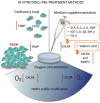Mesenchymal Stem Cells for Neurological Disorders
- PMID: 33854883
- PMCID: PMC8024997
- DOI: 10.1002/advs.202002944
Mesenchymal Stem Cells for Neurological Disorders
Abstract
Neurological disorders are becoming a growing burden as society ages, and there is a compelling need to address this spiraling problem. Stem cell-based regenerative medicine is becoming an increasingly attractive approach to designing therapies for such disorders. The unique characteristics of mesenchymal stem cells (MSCs) make them among the most sought after cell sources. Researchers have extensively studied the modulatory properties of MSCs and their engineering, labeling, and delivery methods to the brain. The first part of this review provides an overview of studies on the application of MSCs to various neurological diseases, including stroke, traumatic brain injury, spinal cord injury, multiple sclerosis, amyotrophic lateral sclerosis, Alzheimer's disease, Huntington's disease, Parkinson's disease, and other less frequently studied clinical entities. In the second part, stem cell delivery to the brain is focused. This fundamental but still understudied problem needs to be overcome to apply stem cells to brain diseases successfully. Here the value of cell engineering is also emphasized to facilitate MSC diapedesis, migration, and homing to brain areas affected by the disease to implement precision medicine paradigms into stem cell-based therapies.
Keywords: cell engineering; homing; mesenchymal stem cells; migration; neurological disorders; regeneration; transplantation.
© 2021 The Authors. Advanced Science published by Wiley‐VCH GmbH.
Conflict of interest statement
The authors declare no conflict of interest.
Figures






References
-
- Zheng W., Honmou O., Miyata K., Harada K., Suzuki J., Liu H., Houkin K., Hamada H., Kocsis J. D., Brain Res. 2010, 1310, 8. - PubMed
Publication types
MeSH terms
LinkOut - more resources
Full Text Sources
Other Literature Sources
Medical
